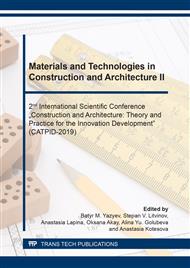[1]
S.S. Kaprielov, A.V. Sheinfeld, G.S. Kardumyan, New modified concretes, Printing house Paradise,, Moscow, (2010).
Google Scholar
[2]
S.S. Kaprielov, A.V. Sheinfeld, G.S. Kardumyan, V.G. Dondukov, Structure and properties of high-strength concretes containing the complex organic-mineral modifier Embelit, Materials of the II All-Rus. Int. Conf. on Concrete and Reinforced Concrete Concrete and reinforced concrete are the ways of development,. 3 (2005) 657-671.
Google Scholar
[3]
G.S. Kardumyan, S.S. Kaprielov, New organomineral modifier series MB, - Embelit for the production of high quality concrete, Building materials. 8 (2005) 12-15.
Google Scholar
[4]
G.V. Nesvetaev, Y.I. Koryanova, A.V. Kolleganov, E-Modulus and creep coefficient of self-compacting concretes and concretes with some mineral additives, Solid State Phenomena. 284 (2018) 963-969.
DOI: 10.4028/www.scientific.net/ssp.284.963
Google Scholar
[5]
S.A. Murtazaev, Y. Bazhenov, M. Salamanova, M. Saidumov, High-performance SCC-concrete at earthquake resistant construction, International journal of envirovmental & science education. 11 (18) (2016) 12779-12786.
Google Scholar
[6]
M.S. Saidumov, M.Sh. Salamanova, T.S.A. Murtazaeva, M.S.M. Hubayev, High-quality modified concrete based on mineral additives and superplasticizers of different nature, Innovations and investments. 8 (2015) 163-166.
Google Scholar
[7]
S-A.Y. Murtazaev, Sh.Sh. Zaurbekov, A.Kh. Alaskhanov, M.S. Saydumov, T.S-A. Murtazaeva, M.R. Khadzhiev, Impact of technogenic raw materials on the properties of high-quality concrete composites, Int. Symp. Engineering and Earth Sciences: Applied and Fundamental Research,. 177 (2018) 275-279.
DOI: 10.2991/isees-18.2018.53
Google Scholar
[8]
G.V. Nesvetaev, A.N. Davidyuk, Self-compacting concrete: shrinkage, Building materials. 8 (2009) 52-53.
Google Scholar
[9]
G.V. Nesvetaev, A.N. Davidyuk, Hyperplasticizers Melflux, for dry building mixes and concrete, Building materials. 3 (2010) 38-40.
Google Scholar
[10]
G.V. Nesvetaev, I.V. Korchagin, Yu.I. Potapova, On the contraction of portland cement in the presence of a superplasticizer, Scientific review. 7 (2014) 842-846.
Google Scholar
[11]
G.V. Nesvetaev, I.V. Korchagin, Yu.Yu. Lopatina, About influence of superplasticizers and mineral additives on creep factor of hardened cement paste and concrete, Solid State Phenomena. 265 (2017) 109-113.
DOI: 10.4028/www.scientific.net/ssp.265.109
Google Scholar
[12]
N.N. Kalinovskaya, D.S. Kotov, E.A. Ivanova, The durability of concrete. Analysis of the causes and ways to reduce shrinkage deformations of modified concrete, Concrete Technology. 11-12 (2017) 14 – 17.
Google Scholar
[13]
S.A. Udodov, M.V. Bychkov, Light self-compacting concrete as an effective construction material, Scientific studies. 4 (17) (2013) 1-7.
Google Scholar
[14]
G.V. Nesvetaev, Concrete, Fenix, Rostov, (2013).
Google Scholar
[15]
G.V. Nesvetaev, I.V. Korchagin, On the effect of superplasticizers on shrinkage of cement stone and concrete, Scientific review. 11-2 (2014) 406-407.
Google Scholar
[16]
G.V. Nesvetaev, Shrinkage that we neglect, Concrete Technology. 5 (2009) 50 – 53.
Google Scholar
[17]
M.P. Nazuyev, A.V. Yanovskaya, M.G. Kholodnyak, A.K. Khalyushev, E.M. Scherban, S.A. Stelmach, The study of the experience of regulating the properties of building products and structures by the directed formation of their variotropic structure, Engineering Journal of Don. 3 (46) (2017) 99.
Google Scholar
[18]
G.V. Nesvetaev, G.S. Kardumyan, T.V. Fan, L.A. Khomich, A.M. Blyagoz, Contraction of portland cement in the presence of superplasticizers and mineral modifiers, New technologies. 4 (2012) 125-128.
Google Scholar
[19]
G.V. Nesvetaev, I.V. Korchagin, Structure and properties of concrete with Glenium superplasticizers on portland cement of the Proletary and Verkhnebakansky plants, Scientific studies. 7 (5) (2015) 1-12.
Google Scholar
[20]
G. Nesvetaev, Y. Koryanova, T. Zhilnikova, On effect of superplasticizers and mineral additives on shrinkage of hardened cement paste and concrete, MATEC Web of Conferences. 196 (2018) 04018.
DOI: 10.1051/matecconf/201819604018
Google Scholar


